easyJet Bundle
How Did easyJet Revolutionize Air Travel?
From its audacious 'Why Not?' campaign to its pioneering low-cost model, easyJet has consistently challenged the status quo of the airline industry. Founded in 1995, this budget airline transformed European air travel, making it accessible to millions. Its success story is a masterclass in strategic marketing and operational efficiency.
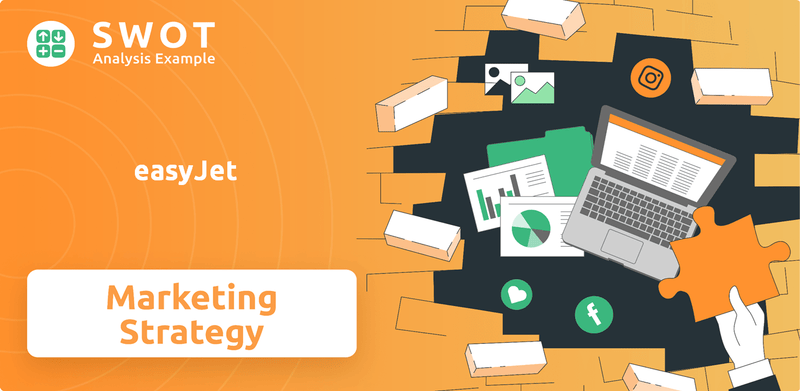
This deep dive explores the easyJet SWOT Analysis, unveiling the secrets behind its enduring success. We'll dissect easyJet's sales strategy, examining how it reaches customers through various channels, and analyze its innovative marketing strategy, including its impactful campaigns. Understanding easyJet's business model provides crucial insights into its competitive advantage, revenue generation, and market share within the evolving aviation landscape, including its digital marketing initiatives.
How Does easyJet Reach Its Customers?
The core of the easyJet sales strategy revolves around a direct-to-consumer model, with its website, easyJet.com, acting as the primary sales channel. This approach allows for direct control over the customer experience and pricing, which is crucial for maximizing revenue. The airline's mobile app also plays a significant role, facilitating bookings, check-ins, and flight management, thereby enhancing customer convenience and driving sales.
easyJet's digital-first approach has been fundamental to its business model since its inception, enabling it to avoid the costs associated with traditional distribution channels like global distribution systems (GDS) and travel agencies. While the company does utilize online travel agencies (OTAs) to broaden its reach, direct online sales consistently account for the majority of bookings. This strategy has been consistently successful, as evidenced by strong booking figures reported in its Q1 2024 trading statement.
The airline continuously invests in its website and app functionalities to improve user experience and boost conversion rates. The focus remains on the efficiency of its online platforms, with no reliance on physical retail locations or direct sales teams in the conventional sense. Key partnerships, such as those with package holiday providers, support growth by offering bundled travel solutions, though the main focus remains on direct flight sales.
easyJet's sales strategy is heavily reliant on its digital platforms, with easyJet.com and its mobile app serving as the primary channels for booking and managing flights. This direct approach enables the airline to maintain control over pricing, ancillary services, and the customer journey, which is a key component of its easyJet business model. The airline also leverages partnerships with package holiday providers to offer bundled travel solutions, but the core focus remains on direct flight sales.
- Website: easyJet.com is the primary platform for direct bookings and managing flights.
- Mobile App: The app facilitates bookings, check-ins, and flight management, enhancing customer convenience.
- Online Travel Agencies (OTAs): easyJet partners with OTAs to broaden its reach, although direct sales dominate.
- Partnerships: Collaborations with package holiday providers offer bundled travel solutions.
easyJet SWOT Analysis
- Complete SWOT Breakdown
- Fully Customizable
- Editable in Excel & Word
- Professional Formatting
- Investor-Ready Format
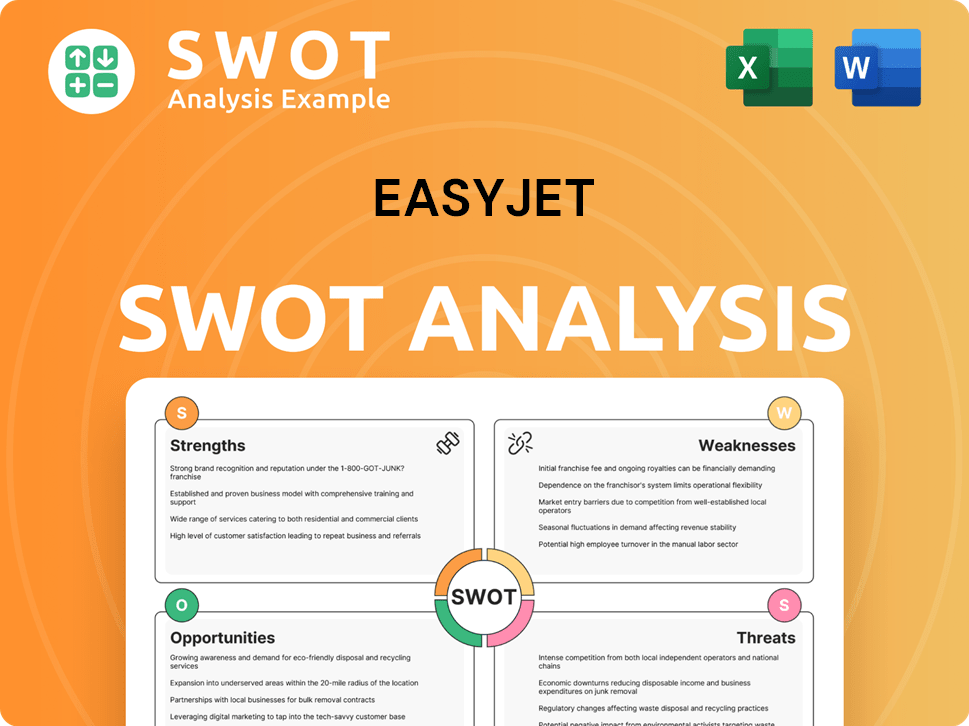
What Marketing Tactics Does easyJet Use?
The Growth Strategy of easyJet heavily relies on a comprehensive marketing strategy to drive sales and maintain its competitive edge. The airline employs a diverse range of marketing tactics, with a strong emphasis on digital channels. This approach allows for targeted campaigns, efficient customer engagement, and data-driven optimization to maximize its reach and revenue.
easyJet's marketing efforts are designed to build brand awareness, attract customers, and boost sales. The company uses content marketing, search engine optimization (SEO), paid advertising, and email marketing to reach its target audience. Social media platforms also play a crucial role in its customer engagement strategy, alongside traditional advertising methods.
The airline's marketing strategy is data-driven, utilizing analytics to understand customer behavior and optimize campaign performance. This includes A/B testing of website features and marketing messages to improve conversion rates. This data-centric approach allows for personalized offers and efficient allocation of marketing resources, which is critical for success in the competitive airline market.
easyJet uses content marketing to inspire travel through destination guides, travel tips, and blog posts. This strategy helps build brand awareness and attract potential customers by providing valuable information and engaging content. Content marketing is a key aspect of the airline's overall marketing strategy.
SEO is crucial for ensuring easyJet ranks highly in search results for relevant flight searches. This helps drive organic traffic to its website and increases visibility. Effective SEO is a cost-effective method for customer acquisition.
Paid advertising campaigns on search engines and social media target specific demographics and routes. These campaigns often feature dynamic pricing messages to attract customers. The use of paid advertising is a key component of the airline's easyJet sales strategy.
Email marketing is used for promotions, personalized offers, and customer relationship management. Customer segmentation based on past travel behavior and preferences allows for targeted and effective campaigns. This strategy is a key element of easyJet customer acquisition strategies.
Social media platforms like Facebook, Instagram, and X are central to easyJet's engagement strategy. These platforms are used for customer service, brand building, and promoting flash sales. Social media is a vital part of the easyJet marketing strategy.
easyJet utilizes analytics to understand customer behavior, optimize campaign performance, and personalize offers. A/B testing of website features and marketing messages is a common practice. This data-centric approach is crucial for easyJet revenue generation methods.
easyJet's marketing mix has evolved to become increasingly data-centric and digitally focused, reflecting the airline's commitment to efficiency and direct customer engagement. Recent innovations include leveraging programmatic advertising for more targeted reach and exploring new social media platforms to connect with younger audiences. The airline's focus on digital channels and data analytics is essential for maintaining its easyJet competitive advantage in the aviation industry.
easyJet's marketing tactics are designed to reach a broad audience while focusing on efficiency and customer engagement. These tactics are continuously refined to adapt to changing market conditions and customer preferences. The airline's approach to marketing is a critical aspect of its easyJet business model.
- Digital Focus: Primarily uses digital channels for advertising, content marketing, and customer engagement.
- Targeted Campaigns: Employs data analytics to target specific demographics and routes with personalized offers.
- Dynamic Pricing: Leverages dynamic pricing messages in advertising to attract customers.
- Social Media: Utilizes social media platforms for customer service, brand building, and promotional activities.
- Data-Driven Optimization: Continuously analyzes data to optimize campaign performance and improve customer acquisition.
easyJet PESTLE Analysis
- Covers All 6 PESTLE Categories
- No Research Needed – Save Hours of Work
- Built by Experts, Trusted by Consultants
- Instant Download, Ready to Use
- 100% Editable, Fully Customizable
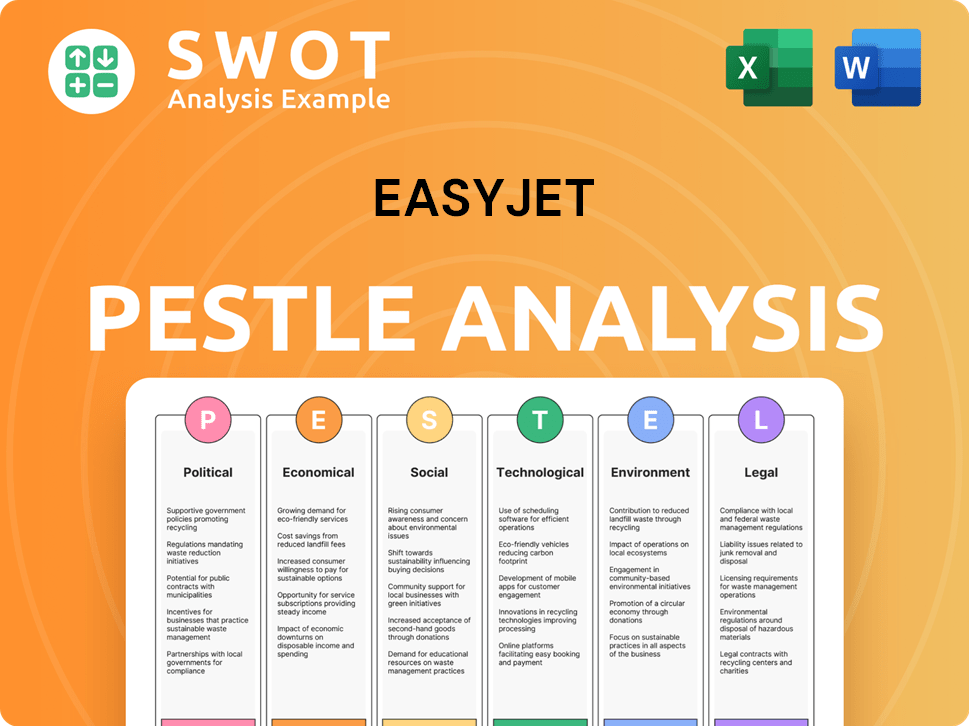
How Is easyJet Positioned in the Market?
The brand positioning of easyJet centers on delivering affordable and accessible short-haul air travel. This is achieved through a 'no-frills' service model, where customers pay only for what they need. The company's distinctive orange livery and straightforward communication style reinforce its commitment to democratizing air travel, making it a recognizable and trusted brand in the aviation industry.
easyJet's value proposition focuses on providing budget-friendly options, appealing to a broad customer base including leisure travelers, families, and business travelers. The airline emphasizes simplicity, efficiency, and punctuality in its customer experience, ensuring ease of booking and travel. This approach has allowed easyJet to establish a strong market presence across Europe, competing effectively with both legacy carriers and other low-cost airlines.
In 2023, easyJet reported a significant increase in revenue, demonstrating the effectiveness of its easyJet sales strategy. The company's ability to maintain a strong brand image while offering competitive prices is key to its success. The focus on operational efficiency and customer satisfaction has allowed easyJet to maintain a competitive edge in the market, as detailed in Owners & Shareholders of easyJet.
easyJet's core value proposition is providing budget-friendly air travel. It focuses on offering low fares by unbundling services and allowing customers to pay only for what they need. This approach directly targets price-sensitive travelers.
The primary target audience includes leisure travelers, families, and business travelers looking for cost-effective options. The airline's network of popular European destinations further appeals to a broad range of customers.
Brand messaging revolves around democratizing air travel, emphasizing simplicity, efficiency, and punctuality. The distinctive orange livery and straightforward tone of voice in communications contribute to brand recognition.
The easyJet competitive advantage lies in its low-cost structure and extensive network of destinations. Operational efficiency and a strong brand reputation for punctuality and customer service further enhance its market position.
easyJet's brand positioning strategy is built on several key elements that contribute to its success. These elements help the company to maintain its market share and attract customers.
- Value Pricing: Offering low fares by unbundling services.
- Extensive Network: Covering popular European destinations.
- Operational Efficiency: Maintaining punctuality and streamlining processes.
- Customer Experience: Focusing on ease of booking and travel.
- Brand Consistency: Ensuring a cohesive experience across all touchpoints.
easyJet Business Model Canvas
- Complete 9-Block Business Model Canvas
- Effortlessly Communicate Your Business Strategy
- Investor-Ready BMC Format
- 100% Editable and Customizable
- Clear and Structured Layout
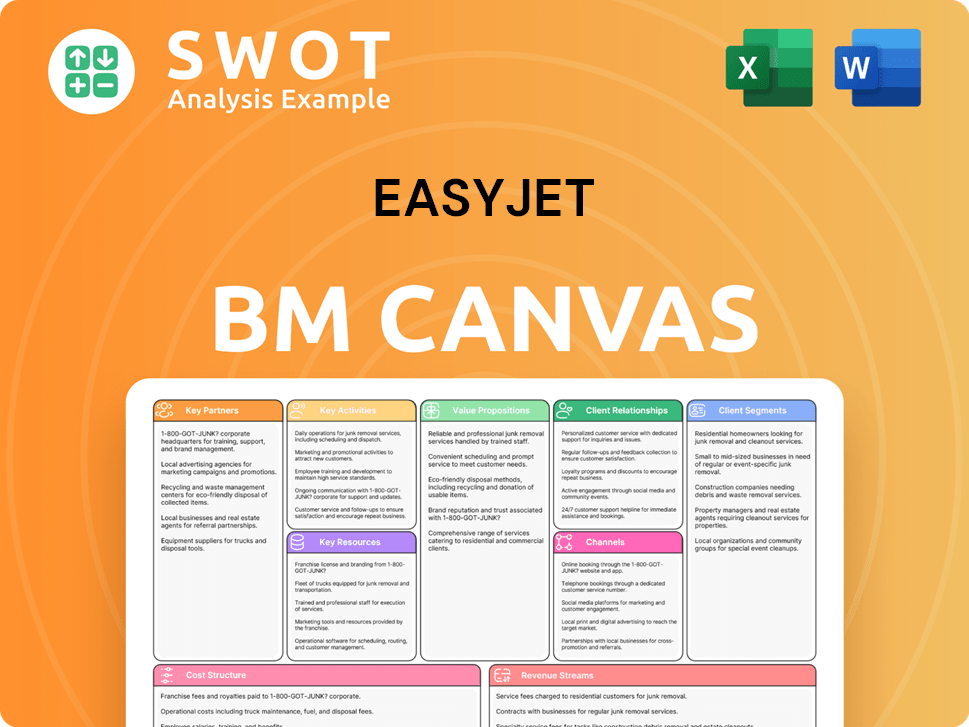
What Are easyJet’s Most Notable Campaigns?
The easyJet sales strategy and marketing strategy have consistently revolved around impactful campaigns designed to boost brand awareness and drive bookings. These initiatives aim to resonate with a broad audience by showcasing the airline's accessibility and commitment to providing value. The focus has been on leveraging various marketing channels, including digital platforms and traditional media, to reach potential customers effectively.
Over the years, easyJet has launched several key campaigns that reflect its evolving business model and market positioning. These campaigns are crucial for maintaining a competitive advantage in the budget airline sector. By focusing on customer engagement and highlighting key differentiators, easyJet aims to remain a preferred choice for travelers.
A detailed easyJet market analysis reveals the importance of strategic marketing in sustaining its growth. Campaigns are designed to adapt to changing consumer preferences and address new challenges, such as sustainability concerns. The airline's ability to innovate in its marketing approach is central to its long-term success.
Launched in 2015, this campaign highlighted the diverse range of passengers flying with the airline. It aimed to showcase easyJet's role in connecting people and cultures. The campaign used TV, print, and digital channels to generate brand visibility and positive sentiment.
Focusing on reducing carbon emissions, these campaigns promote easyJet's commitment to sustainability. They highlight investments in new, fuel-efficient aircraft, such as the Airbus A320neo family. These campaigns are primarily executed on digital platforms, including social media and the company's website.
The use of social media is a key component of easyJet's marketing strategy. The airline frequently collaborates with travel influencers to promote destinations and experiences. This approach helps boost engagement and drive bookings by leveraging the influencers' reach and audience.
easyJet's digital marketing initiatives are essential for reaching its target audience. These include targeted advertising, content marketing, and search engine optimization. The airline's website and mobile app are central to its customer acquisition strategies, providing a seamless booking experience.
The effectiveness of easyJet's marketing campaigns is crucial for its revenue generation methods. For a deeper dive into the financial aspects and strategic decisions, see this article on easyJet's business model and financial performance. These campaigns are designed to enhance easyJet's brand positioning strategy and address easyJet sales and marketing challenges.
The campaigns are tailored to attract a broad demographic, emphasizing accessibility and value. easyJet targets both leisure and business travelers. The focus is on affordability and convenience, making the airline appealing to a wide range of customers.
easyJet frequently uses promotional offers and discounts to attract customers. These include early booking deals, seasonal sales, and package deals. These strategies are aimed at driving immediate sales and increasing booking volumes, contributing to the overall easyJet revenue.
Customer Relationship Management (CRM) is a key part of easyJet's strategy. The airline uses CRM to personalize offers and enhance customer experience. This approach helps improve customer loyalty and encourage repeat bookings.
easyJet employs a mix of advertising strategies, including digital advertising, TV commercials, and print media. These campaigns are designed to increase brand awareness and drive bookings. The advertising efforts are carefully targeted to reach relevant customer segments.
The effectiveness of these campaigns contributes to easyJet's market share and growth. By consistently implementing successful marketing initiatives, easyJet aims to maintain its position as a leading low-cost carrier in the competitive airline industry. The airline continues to adapt its strategies to meet market challenges.
A thorough competitor analysis helps easyJet refine its marketing efforts. The airline monitors the strategies of its competitors to identify opportunities and maintain its competitive advantage. This analysis informs the development of new campaigns and promotional offers.
easyJet Porter's Five Forces Analysis
- Covers All 5 Competitive Forces in Detail
- Structured for Consultants, Students, and Founders
- 100% Editable in Microsoft Word & Excel
- Instant Digital Download – Use Immediately
- Compatible with Mac & PC – Fully Unlocked
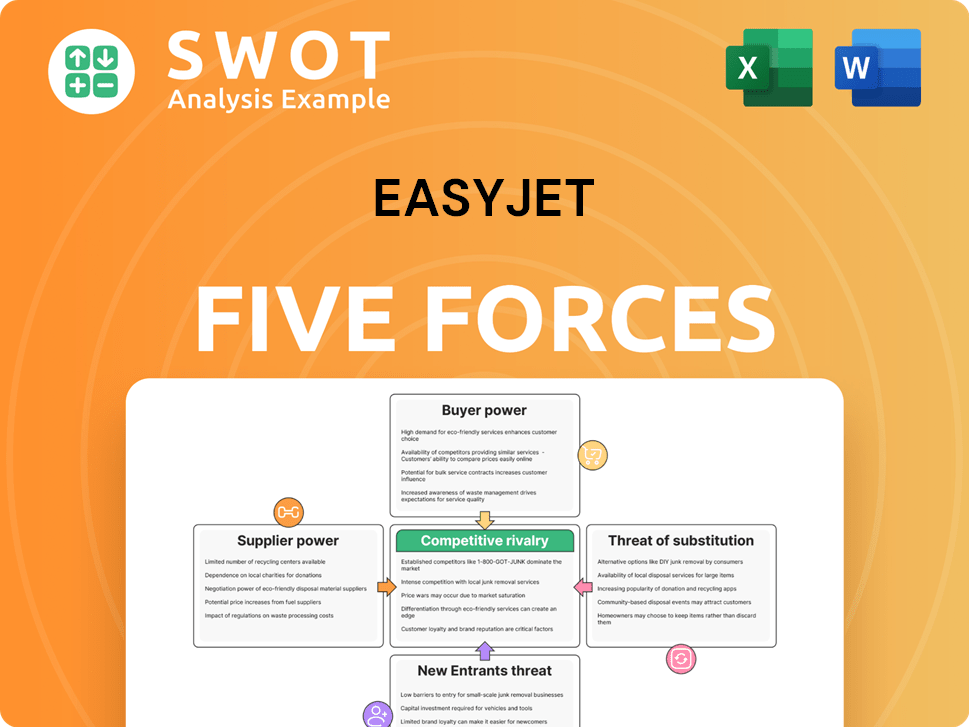
Related Blogs
- What are Mission Vision & Core Values of easyJet Company?
- What is Competitive Landscape of easyJet Company?
- What is Growth Strategy and Future Prospects of easyJet Company?
- How Does easyJet Company Work?
- What is Brief History of easyJet Company?
- Who Owns easyJet Company?
- What is Customer Demographics and Target Market of easyJet Company?
Disclaimer
All information, articles, and product details provided on this website are for general informational and educational purposes only. We do not claim any ownership over, nor do we intend to infringe upon, any trademarks, copyrights, logos, brand names, or other intellectual property mentioned or depicted on this site. Such intellectual property remains the property of its respective owners, and any references here are made solely for identification or informational purposes, without implying any affiliation, endorsement, or partnership.
We make no representations or warranties, express or implied, regarding the accuracy, completeness, or suitability of any content or products presented. Nothing on this website should be construed as legal, tax, investment, financial, medical, or other professional advice. In addition, no part of this site—including articles or product references—constitutes a solicitation, recommendation, endorsement, advertisement, or offer to buy or sell any securities, franchises, or other financial instruments, particularly in jurisdictions where such activity would be unlawful.
All content is of a general nature and may not address the specific circumstances of any individual or entity. It is not a substitute for professional advice or services. Any actions you take based on the information provided here are strictly at your own risk. You accept full responsibility for any decisions or outcomes arising from your use of this website and agree to release us from any liability in connection with your use of, or reliance upon, the content or products found herein.